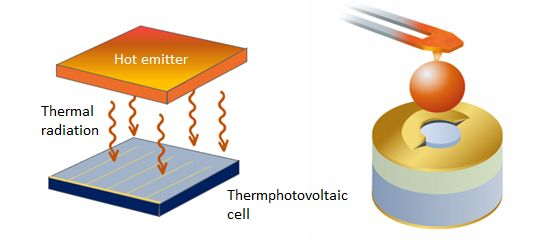
Research activities
Converting thermal radiation into electricity: a milestone is reached
Research teams from CETHIL and IES in Montpellier have demonstrated the possibility of converting thermal radiation from a moderate temperature surface (~ 450 °C) into electrical power with an efficiency greater than 10 %. By approaching the emitting surface at a short distance from the infrared photovoltaic cell, an electrical power density a thousand times higher than that of previous studies was obtained.
Harnessing energy from the surrounding environment is a key scientific challenge for developing carbon-free energy production without greenhouse gas emissions. Photovoltaic (PV) conversion, which harvests visible and near infrared light emitted by the sun, is well known today. It is also possible to harvest thermal radiation from hot surfaces, in the mid-infrared spectral range: this is termed thermophotovoltaic (TPV) conversion. This field has been booming for ten years.
Recent results have shown that it is possible to achieve a conversion efficiency of the order of 30% for thermophotovoltaic cells if the inefficient part of the radiation, which cannot be converted, is not absorbed. Unfortunately, this improvement in efficiency does not lead to an increase of the density of extracted electrical power, which remains limited to a few kW/m2 by Planck's law, and requires very-high emitter temperatures, above 1000 °C. In 2008, however, it was experimentally demonstrated that the radiative power exchanged by two bodies a few hundred or even tens of nanometers apart - they are then said to be "in the near field" - can exceed the Planck limit. A photon tunnel effect makes it possible to transfer a much larger quantity of radiation.
Recent experiments from teams of the Centre for Energy and Thermal Sciences in Lyon (CETHIL, CNRS / INSA Lyon - Micro and Nanoscale Heat Transfer theme, MiNT) and from the Institute of Electronics and Systems (IES, CNRS / University of Montpellier) use this effect and then convert the exchanged radiation into electrical power. The researchers thus obtained electrical power per unit surface area of 7 kW/m2, a performance about a thousand times higher than previous near-field studies. This level of power per unit surface area is comparable to the best performance obtained in the far field, but with a much lower temperature (~ 450 °C), which is therefore closer to the temperatures of common heat sources. This performance is made possible by the use of 'very low' bandgap cells, for which the bandgap energy of photons (~ 0.2 eV) is associated with wavelengths in the infrared, which allows conversion efficiencies of the order of 10 to 20 %. These cells are made of indium antimonide (InSb). They need currently to be cooled (77 K), but work shows that other strategies for obtaining 'very low' bandgap cells that would operate at room temperature appear viable. Micron-size cells were used in these first tests, which make it possible to produce a power of a few microwatts. It is now time to increase the size of these promising devices.
The study is reported in a Press Release from CNRS (in French: Communiqué de presse du CNRS) and mentioned in the local newspaper Lyon Capitale: "Ils transforment de la chaleur directement en électricité"
Principle of thermophotovoltaic conversion (left) and implementation with a micron-size near-field cell, which requires the hot emitter to be brought very close to the surface of the cell (right).Credits : CETHIL et IES.

Detailed information
Early version freely available on the ArXiV preprint server.
Broad-audience article (in French):
Thermophotovoltaïque : des cellules PV pour convertir le rayonnement thermique, C. Lucchesi, R. Vaillon, P.O. Chapuis, Photoniques 105, 37-40 (2020)
